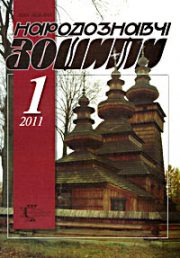The Ethnology Notebooks. 2021. № 5 (161), 1096—1103
UDK [061.23:7](438.11=161.2)”1927/1939″
DOI https://doi.org/10.15407/nz2021.05.1096
YATSIV Roman
- ORCID ID: https://orcid.org/0000-0003-1509-5367
- PhD, professor at the Artwood department
- of the Lviv National Academy of Arts,
- 38, V. Kubiyovycha str., 79011, Lviv, Ukraine,
- Contacts: e-mail: jaciv@ukr.net
Abstract. The article considers the history of foundation and ideological principles of the institutional activity of the Ukrainian art group «Spokij» that left a significant mark in the history of Ukrainian emigration of the 20th century.
The aim of the article is to scientifically qualify the creative ideologeme of the «vision of homeland» as uniting the members of the group strategy of national cultural progress in the circumstances of temporary exile. The rich factual material traces the dynamics of events in the system of communication between public and political figures, artists, writers, scientists in different locations of Warsaw in the period between the two world wars.
The relevance of the article is that the structure of ideological motivation of creativity along with accompanying factors of social and cultural activity is considered for the first time in historiography of the life of Ukrainian emigration.
The object of research is the forms of organization of cultural and artistic life of Ukrainian emigration in Warsaw (the capital of the Second Polish Republic) — exhibitions, ethnographic expeditions, creative parties, lectures, publications in mass media, works of art, etc.
The subject of the research is the ideological vector of the activity of the Ukrainian art group «Spokij» as the largest and most authoritative institutional formation of the Ukrainian emigration in Warsaw.
The methodological basis of the study is the historical-cultural and structural-typological approaches in the implementation of academic reconstruction of the dynamics of socio-political, cultural and intellectual life in the realities of emigration.
Keywords: history of Ukraine, Ukrainian emigration, Warsaw, ethnic culture, ideology, intercultural dialogue, cultural, academic institutions, group «Spokij», ethnography, fine arts, painting, graphics, modernism, formalism, ideological and aesthetic worldview, moral and value imperative.
Received 25.10.2021
REFERENCES
- Shelukhin, S. (1926). The Warsaw Pact between the Poles and S. Petliura on April 21, 1920. Prague: New Ukraine [in Ukrainian].
- Narizhnyj, S. (1942). Ukrainian emigration. Cultural work of Ukrainian emigration between the two world wars. Part one. Prague [in Ukrainian].
- Narizhnyj, S. (1999). Ukrainian emigration. Cultural work of the Ukrainian emigration 1919—1939. Materials collected by S. Narizhnyj to the second part. Kyiv: Olena Teliha Publishing House [in Ukrainian].
- Vyunyk, A., & Batih, M. (1970). Graphics. History of Ukrainian art: in six volumes. The Art of the second half of the 19th—20th centuries (Vol. 4, book 2). Kyiv [in Ukrainian].
- Kolanczuk, A. (1995). Internowani zolnierze Armii UNR w Kaliszu. 1920—1939. Kalisz; Przemysl; Lviv [in Polish].
- Kolyanchuk, O. (2003). Lantsut: Ukrainian War Memorial. Przemysl [in Ukrainian].
- Kolyanchuk, O. (2003). Pykulychi: Ukrainian War Memorial. Przemysl [in Ukrainian].
- Wiszka, E. (2001). Prasa emigracji ukrainskiej w Polsce 1920—1939. Torun: Wydawnictwo Uniwersytetu Mikolaja Kopernika [in Polish].
- Ainenkel, A. (1998). Poland’s policy towards the Ukrainians in the interwar period. Selected issues. Ukraine — Poland: hard issues. Proceedings of the II International Seminar of Historians «Ukrainian-Polish Relations in 1918—1947». Warsaw, May 22—24, 1997 (Vol. 1—2, pp. 29—46). Warsaw: World Union of Soldiers of the Home Army; Association of Ukrainians in Poland [in Ukrainian].
- Ainenkel, A. (2006). The Ukrainian question in the politics of the Second Rzeczpospolita and the concepts and measures of Ukrainian political forces in the interwar period (1918—1939). Ukraine — Poland: hard issues. Proceedings of the XI International Seminar of Historians «Ukrainian-Polish relations during the Second World War». Warsaw, April 26—28, 2005 (Vol. 10, pp. 141—154). Warsaw: World Union of Soldiers of the Home Army; TIRSA [in Ukrainian].
- Kucherepa, M. (1998). National policy of the Second Rzeczpospolita towards Ukrainians (1919—1939). Ukraine — Poland: hard issues. Proceedings of the II International Seminar of Historians «Ukrainian-Polish Relations in 1918—1947». Warsaw, May 22—24, 1997 (Vol. 1—2, pp. 11—28). Warsaw: World Union of Soldiers of the Home Army; Association of Ukrainians in Poland [in Ukrainian].
- Kucherepa, M. (2006). The Ukrainian problem in the politics of the Second Rzeczpospolita and in the concepts and actions of Ukrainian political forces in the interwar period. UkrainePoland: hard issues. Proceedings of the XI International Seminar of Historians «Ukrainian-Polish relations during the Second World War». Warsaw, April 26—28, 2005 (Vol. 10, pp. 155—190). Warsaw: World Union of Soldiers of the Home Army; TIRSA[in Ukrainian].
- Portnov, A. (2008). Science in Exile: Scientific and Educational Activities of the Ukrainian Emigration in the Interwar Poland (1919—1939). Kharkiv: HIFT [in Ukrainian].
- Yatsiv, R. (2008). Oleksa Shatkivskyj and the Ukrainian Art Group «Spokij»: Materials on the History of Ukrainian Art of the 1920s and 1930s. Lviv: Raster-7 [in Ukrainian].
- Yatsiv, R. (1998). Ukrainian intellect on the art map of Europe in the 1900s — early 1920s. Notes of the NTSh. (Volume CCXXXVI: Proceedings of the Commission of Fine and Applied Arts, pp. 185—224). Lviv [in Ukrainian].
- Yatsiv, R. (2001). «Spokij»: Resources of the spirit. Bulletin of NTSh (Part 26, pp. 26—29). Lviv [in Ukrainian].
- Yatsiv, R. (1998). History through the eyes of hope: Petro Andrusiv. Art of the Ukrainian Diaspora: Returned Names (Issue I, pp. 192—220).Kyiv: Triumph [in Ukrainian].
- Malanyuk, E. (1929). Tank Group. Articles about Tank (Pp. 5—7). Warsaw [in Ukrainian].
- (1919). UIB To the conscience of the cultural world. Wolia. Weekly (Part 1, pp. 22—23). Vienna [in Ukrainian].
- (-HH-). (1937, 1 november). Decades of the art group «Spokij». Literary and scientific supplement to the «New Time». Lviv [in Ukrainian].
- Malanyuk, E. (1929). Tank Group. Articles about Tank (Pp. 5—7).Warsaw [in Ukrainian].
- Lypa, Y. (1929). Letter to writers. Articles about Tank (Pp. 8—11). Warsaw [in Ukrainian].
- Mehyk, P. (1931). [Introduction] Ukrainian art group «Spokij»: Catalog of the V exhibition. Warsaw [in Ukrainian].





